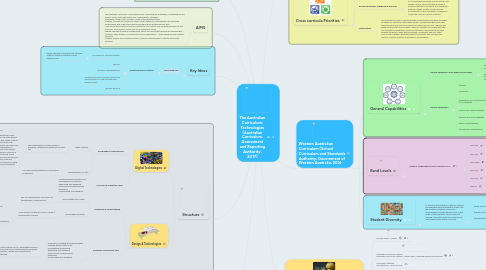
1. Key Ideas
1.1. Overaching idea
1.1.1. Creating preferred futures
1.1.1.1. THINKING IN TECHNOLOGIES:
1.1.1.1.1. Design Thinking. Computational Thinking, Systems Thinking. Creative-Critical Thinking Skills.
1.1.1.2. SAFETY
1.1.1.3. PROJECT MANAGEMENT
1.1.1.4. INFORMATION AND COMMUNICATION TECHNOLOGY IN THE AUSTRALIAN CURRICULUM
1.1.1.5. ANIMAL ETHICS
2. Rationale
2.1. The Australian Curriculum: Technologies ensures that all students benefit from learning about and working with traditional, contemporary and emerging technologies that shape the world in which we live. By applying their knowledge and practical skills and processes when using technologies and other resources to create innovative solutions, independently and collaboratively, they develop knowledge, understanding and skills to respond creatively to current and future needs.
3. AIMS
3.1. The Australian Curriculum: Technologies aims to develop the knowledge, understanding and skills to ensure that, individually and collaboratively, students: Investigate, design, plan, manage, create and evaluate solutions Creative, innovate and enterprise when using traditional, contemporary and emerging technologies, and understand how technologies have developed over time Make informed and ethical decisions about the role, impact and use of technologies in the economy, environment and society for a sustainable future Engage confidently with and responsibly select and manipulate appropriate technologies − materials, data, systems, components, tools and equipment − when designing and creating solutions Critique, analyse and evaluate problems, needs or opportunities to identify and create solutions.
4. Structure
4.1. Digital Technologies
4.1.1. Knowledge & Understanding
4.1.1.1. Digital systems
4.1.1.1.1. The components of digital systems: hardware, software and networks and their use
4.1.1.2. Representation of data
4.1.1.2.1. How data are represented and structured symbolically
4.1.2. Processes & Production Skills
4.1.2.1. Creating designed solutions by: investigating and defining generating and designing producing and implementing evaluating collaborating and managing
4.2. Design & Technologies
4.2.1. Knowledge & Understanding
4.2.1.1. Technologies and society
4.2.1.1.1. The use, development and impact of technologies in people’s lives
4.2.1.2. Technologies contexts
4.2.1.2.1. Technologies and design across a range of technologies contexts
4.2.2. Processes & Production Skills
4.2.2.1. Collecting, managing and analysing data. Creating digital solutions by: investigating and defining generating and designing producing and implementing evaluating collaborating and managing
4.2.2.1.1. These require skills in using digital systems; and critical and creative thinking including systems, design and computational thinking.
5. Band Levels
5.1. The curriculum for each Technologies subject is written in bands of year levels: Foundation – Year 2 Years 3 and 4 Years 5 and 6 Years 7 and 8 Years 9 and 10.
6. Cross curricula Priorities
6.1. Aboriginal and Torres Strait Islander histories and cultures
6.1.1. Students explore how Aboriginal and Torres Strait Islander Peoples' capacity for innovation is evident through the incorporation and application of a range of traditional, contemporary and emerging technologies and practices to purposefully build and/or maintain cultural, community and economic capacity
6.2. Asia and Australia's engagement with Asia
6.2.1. Students develop knowledge and understanding of technologies processes and production and related cultural, social and ethical issues. It enables students to recognise that interaction between human activity and the diverse environments of the Asia region continues to create the need for creative solutions
6.3. Sustainability
6.3.1. Technologies focuses on the knowledge, understanding and skills necessary to design for effective sustainability action. It recognises that actions are both individual and collective endeavours shared across local, regional and global communities and provides a basis for students to explore their own and competing viewpoints, values and interests. Understanding systems enables students to work with complexity, uncertainty and risk; make connections between disparate ideas and concepts; self-critique; and propose creative solutions that enhance sustainability.
7. Technologies Content Structure
7.1. Digital Technologies
7.1.1. Sequence of Content
7.1.2. Sequence of Achievement
7.2. Design & Technologies
7.2.1. Sequence of Content
7.2.2. Sequence of Achievement
8. USEFUL RESOURCES FOR PLANNING
8.1. Scootle Home - Scootle
8.2. Australian Curriculum Lessons: Australian Curriculum Lessons - Lesson Plans, Teaching Resources and more
8.3. Curriculum Materials: Cool Australia - Learn For Life
8.4. Technologies Curriculum: Resources for Teachershttp://dtm4260.edublogs.org/?s=boogie+bot&submit=Search
8.4.1. Interesting Technologies worth investigating and implementing in my classroom practice.
8.4.1.1. Touch Develop & Codebug: Technology in the Australian Classroom – Technologies
8.4.1.2. CoderDojo | Technologies Curriculum- Resources for Teachers
8.5. Pinterest
9. Western Australian Curriculum (School Curriculum and Standards Authority, Government of Western Australia, 2014
9.1. General Capabilities
9.1.1. General capabilities & the Digital Technologies
9.1.1.1. General capabilities concerns students exploring HOW to use iCT.
9.1.1.2. Digital technologies concerns students exploring how to design and work with technology at s deeper level.
9.1.2. General capabilities
9.1.2.1. Literacy
9.1.2.2. Numeracy
9.1.2.3. Information and communication technology (ICT) capability
9.1.2.3.1. Digital Technologies
9.1.2.3.2. Design & Technologies
9.1.2.4. Critical and creative thinking
9.1.2.5. Personal and social capability
9.1.2.6. Ethical understanding
9.1.2.7. Intercultural understanding
9.2. Band Levels
9.2.1. Design & Technologies Scope & Sequence P-6
9.2.1.1. Year One
9.2.1.2. Year Two
9.2.1.3. Year Three
9.2.1.4. Year Four
9.2.1.5. Year Five
9.2.1.6. Year Six
9.3. Student Diversity
9.3.1. All students are entitled to rigorous, relevant and engaging learning programs drawn from the Western Australian Curriculum: Technologies. Teachers take account of the range of their students' current levels of learning, strengths, goals and interests and make adjustments where necessary
9.3.1.1. Gifted and talented students
9.3.1.2. English as an additional language or dialect
9.3.1.3. Students with disability
